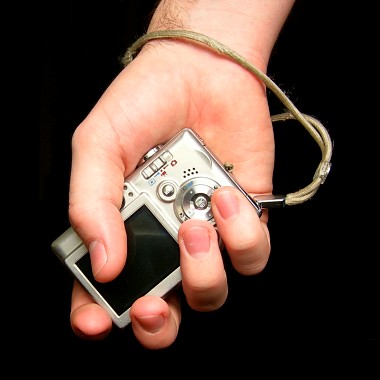How I use my camera
When out hiking, I carry my camera (a 5MP Canon SD400) like this:

When not in a photogenic environment (or mood), the camera slips into my pocket or into a small neoprene sleeve in my cargo shorts.
Trudging through the Virgin River was no different (except I kept the camera in my hand—above the river—the whole time). Not only does being able to hold the camera in the palm of my hand keep it available at a moment’s notice, it also affords some protection from the elements (e.g. a light sprinkling rain at Arches or river splashes at Zion). Presumably on account of its size, more than anything else, I’ve taken well over 10,000 shots in the 2 and half years since I purchased this camera.
99% of the time, I use the LCD to frame my shots. Not only does it provide a more accurate representation of the final photo, but it’s easier to see than squinting through the view finder. It also feels more natural, especially in social settings. I’m not “the photographer” who constantly has a camera in front of his face. I’m an active participant who happens to be taking the occasional photo. I emphasize this because I’ve read things like the following quote that strike me as almost anachronistic:
I probably wouldn’t have bothered to quote that if it weren’t for that aghast exclamation point at the end. Of course the review was written in 2005, and times change. It does remind me of Clay Shirky’s post, The Future Belongs to Those Who Take The Present For Granted where he says:
I had this thought while talking to Robert Cook of Metaweb, who are making Freebase. Freebase needs structured metadata, lots of structured metadata, and one of the places they are getting it is from Wikipedia, by spidering the bio boxes (among other things) for things like birthplace and age of people they list in the database. While Andrew Keen is trying to get a conversation going on whether Wikipedia is a good idea, Metaweb takes it for granted as a stable part of the environment, which lets them see past this hurdle to the next one.
This really resonates with me. Again and again.
I turn my camera off between shots, to preserve battery power and to further protect the lens surface. That said, my camera appears to have some sort of motion activated gyroscope that turns off the LCD when not in use, and knows to turn it back on when I flick it back up to my eye.
When I shoot, 99% of the time I use the camera’s “manual” mode. The exposure setting is usually stopped down 2/3 because I find that it tends to overexpose shots, especially in broad daylight. I adjust it down further in ultra-bright situations. It’s easier to fix an underexposed picture than an overexposed one. I also set up the white balance in advance. Auto-white balance works ok some of the time, but I often use the sunny and cloudy settings depending on conditions outdoors and the Tungsten setting for indoors shots in low light. I’ll very occasionally set the ISO to 200 or 400 in low light situations.
I almost never use the flash, except to experiment with shadowy outdoor settings, or to take non-artistic settings indoors (e.g. a group photo at some party or event).
I use the macro focus setting occasionally because I like taking close-up pictures of flowers and food. But the results (and depth of field) are sometimes unpredictable, so I usually take 2-3 shots at slightly different angles and distances to ensure at least one comes out ok. If there was one setting I wish my camera had, it would be to manually adjust the aperture to predictably reduce the depth of field (like those Dooce and 101 Cookbooks macro shots). When that effect happens in my photos, usually I feel like I got lucky.
I never touch the zoom 99% of the time. When I do use the zoom, I usually zoom in all the way, and the result is rarely a photograph (compositionally) that I want to show off. To me, using the zoom feels like taking pictures through a microscope. I’m much more of an immersive wide-angle landscape photographer than a zoomed-in animals in nature photographer. Zooming in on things makes me feels like I’m cropping out life.
My camera has the ability to record very decent video and ok sound, a feature I barely use (but wish I did) because I don’t have a good platform for editing video.
The final product of 99% of the photos I take are resized and processed down to a 380 pixel wide image that goes up on my blog. Excepting situations where I stitch together multiple photos into a panorama, that means I’m only displaying either 108,300 landscape or 192,280 portrait pixels from the original 5 megapixel image. Granted I’ll frequently crop the original 5MP shot before resizing it to improve the composition, but the sharpness of the original 5MP image is something that has little to no bearing on how I’ll actually use the image. I’m rarely making prints (once a year, if even) and I’ve never made a print larger than 8×10.